prime minister
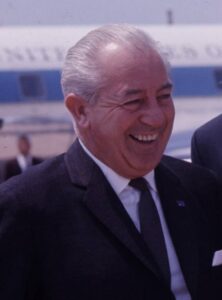
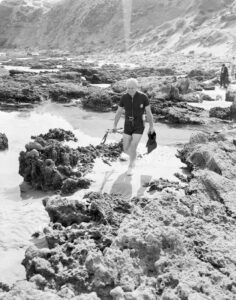 When someone goes missing, it leaves a number of people at a standstill, so to speak. At first, they think they can find the person quickly, but then, if the ordeal carries on for a while, they begin to lose hope of ever seeing their loved one again. When the missing person is someone of prominence, the case goes very public, very quickly, and while that could help find the person, it also puts a negative connotation on the situation.
When someone goes missing, it leaves a number of people at a standstill, so to speak. At first, they think they can find the person quickly, but then, if the ordeal carries on for a while, they begin to lose hope of ever seeing their loved one again. When the missing person is someone of prominence, the case goes very public, very quickly, and while that could help find the person, it also puts a negative connotation on the situation.
On December 17, 1967, in what turned out to be an unsolved missing person case, Harold Edward Holt, who was Australia’s 17th Prime Minister and a member of parliament for 32 years, disappeared during his first term in office as Prime Minister. He was never found, and the case remains unsolved to this day. That December 17th was a Sunday morning. Holt decided to drive down to Melbourne with friends and bodyguards to see British Yachtsman Alec Rose sail through port. The plan was to watch the yacht go through, and then head down to Holt’s favorite swimming and snorkeling spot at Cheviot Beach, east of Port Phillip Bay. While there, Holt decided to take a swim. Holt went down to the water, which has notoriously strong currents and rip tides. Soon after going in, Holt disappeared from view and the situation quickly escalated into one of Australia’s largest search operations ever, but the search was in vain, and Holt was never found.
Now, this might seem like a simple case of drowning, but with no body found, there is always room for speculation as to the “real” reason for his disappearance. People began to speculate that he was caught in strong currents and then dragged underwater and whisked further out to sea. That would be the most logical cause of his disappearance, but it was also speculated that he may have faked his own death to run off with his mistress. It seems strange that he would walk away from his sons too, but you never know.
Holt was born on August 5, 1908, at his parents’ home in Stanmore, New South Wales, a suburb of Sydney. He was the first of two sons born to Olive May (née Williams; formerly Pearce) and Thomas James Holt. In 1927, Holt began studying law at the University of Melbourne, while living at Queen’s College on a scholarship. He represented the university in cricket and football, and was also active in various student organizations, serving as president of the Law Students’ Society and of the Queen’s College Social Club. Holt won prizes for oratory and essay-writing and was a member of the inter-university debating team. He graduated with a Bachelor of Laws degree in 1930. Holt’s father, who was living in London, invited him to continue his studies in England, but he declined the offer. Holt served his articles of clerkship with the firm of Fink, Best, and Miller. He was admitted to the Victorian Bar in late 1932 and opened his own legal practice the following year. Unfortunately, the Depression brought with it few clients, and he was frequently underpaid. During those years, he lived in a boardinghouse and often relied upon the hospitality of friends. It was this time in his life that made him consider politics. Holt married Zara Dickins, the daughter of a Melbourne businessman, after an on 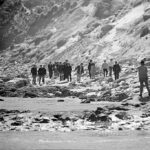
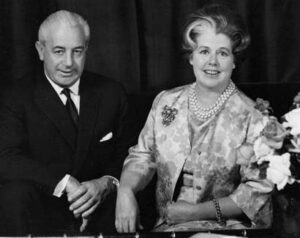 again off again, relationship, and her first marriage to James Fell, a British Indian Army officer. He later adopted her three children, and many people thought he was probably the biological father of her twins, Sam and Adrew, who look a lot like Holt. She also had an older son named Nicholas, whom Holt adopted as well. After his presumed drowning, Zara Holt said that he had been involved in a number of extramarital affairs, sparking the idea that maybe he wasn’t really dead. I doubt we will ever know. A memorial service was held on December 22nd, at St Paul’s Cathedral, Melbourne.
again off again, relationship, and her first marriage to James Fell, a British Indian Army officer. He later adopted her three children, and many people thought he was probably the biological father of her twins, Sam and Adrew, who look a lot like Holt. She also had an older son named Nicholas, whom Holt adopted as well. After his presumed drowning, Zara Holt said that he had been involved in a number of extramarital affairs, sparking the idea that maybe he wasn’t really dead. I doubt we will ever know. A memorial service was held on December 22nd, at St Paul’s Cathedral, Melbourne.
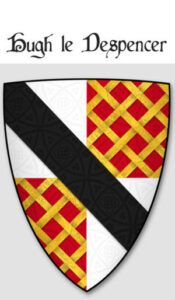 For many years, I thought my Spencer line came from England, but some things didn’t quite add up. When I started seeing DeSpencer and Le DeSpencer, I suspected that we might have immigrated to England from France, which my DNA proved to be correct. I’m more French than English. Nevertheless, for centuries, my Spencer ancestors did live in England, married English people, and so the line blended into more English blood in the current Spencers.
For many years, I thought my Spencer line came from England, but some things didn’t quite add up. When I started seeing DeSpencer and Le DeSpencer, I suspected that we might have immigrated to England from France, which my DNA proved to be correct. I’m more French than English. Nevertheless, for centuries, my Spencer ancestors did live in England, married English people, and so the line blended into more English blood in the current Spencers.
One Hugh le DeSpencer, who was the 1st Baron le DeSpencer, whose connection to me, while most assuredly there, would have to be researched to determine the level of cousinship, or whatever other relationship it is; was an important ally of Simon de Montfort during the reign of Henry III. He served briefly as Justiciar of England in 1260. In the “Middle Ages in England and Scotland the Chief Justiciar was roughly equivalent to a modern Prime Minister of the United Kingdom as the monarch’s chief minister.” Baron le DeSpencer also served as Constable of the Tower of London. “The Constable of the Tower is the most senior appointment at the Tower of London. In the 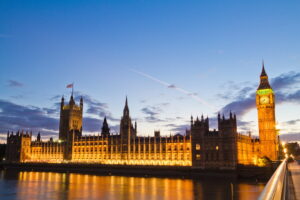 Middle Ages a constable was the person in charge of a castle when the owner…the king or a nobleman…was not in residence. The Constable of the Tower had a unique importance as the person in charge of the principal fortress defending the capital city of England.”
Middle Ages a constable was the person in charge of a castle when the owner…the king or a nobleman…was not in residence. The Constable of the Tower had a unique importance as the person in charge of the principal fortress defending the capital city of England.”
As chief justiciar of England, Hugh Le DeSpencer, first played an important part in 1258, when he was prominent on the baronial side in the Mad Parliament of Oxford, so called because they apparently argued a lot… and because of a possible misspelling of the word insigne as insane in whatever this says…”Hoc anno fuit illud insane parliamentum apud Oxoniam.” In 1260 the barons chose Le DeSpencer to succeed Hugh Bigod as Justiciar, and in 1263 the king was further compelled to put the Tower of London in his hands. He was the son 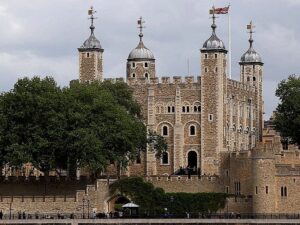 of Hugh le DeSpencer I, born in about 1223 and was summoned to Parliament by Simon de Montfort. Hugh was summoned as Lord DeSpencer on December 14, 1264 and was Chief Justiciar of England and a leader of the baronial party, and so might be deemed a baron, although that may not have been completely legal.
of Hugh le DeSpencer I, born in about 1223 and was summoned to Parliament by Simon de Montfort. Hugh was summoned as Lord DeSpencer on December 14, 1264 and was Chief Justiciar of England and a leader of the baronial party, and so might be deemed a baron, although that may not have been completely legal.
He remained allied with Montfort to the end, and was present at the Battle of Lewes. He was killed fighting on de Montfort’s side at the Battle of Evesham in August 4, 1265. He was slain by Roger Mortimer, 1st Baron Wigmore. That killing caused a feud to begin between the DeSpencer and the Mortimer families.

